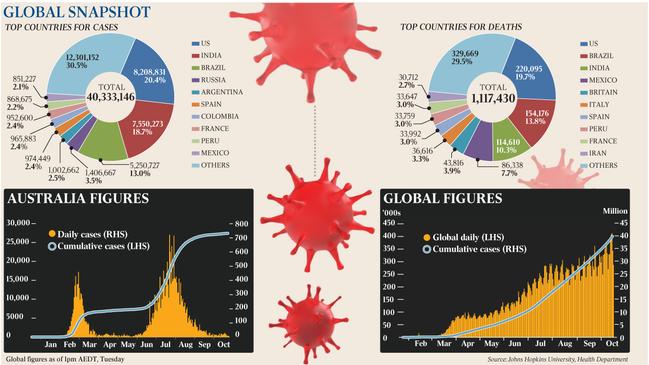COVID-19: Racing towards 50 million as pandemic gathers pace
It’s a near certainty that in less than a month the world will be marking 50 million cases of COVID-19.

There’s no denying the numbers: coronavirus is spreading across the world at an accelerated pace. The global case tally is now more than 40 million — and that’s only the official figures. It’s a near certainty that in less than a month, the world will be marking 50 million cases of COVID-19.
As a second wave of disease spreads across Europe, there are no complex scientific reasons why the pace of infection is gathering pace. Some blame plummeting temperatures in the northern hemisphere, but overwhelmingly the cause is clear: exponential growth is the nature of a pandemic. It simply accelerates.
It took three months for the world to reach 10 million cases, a further 44 days to hit 20 million, 38 days to get from 20 to 30 million, and just 32 days later, the tally hit 40 million cases. Almost 400,000 cases of COVID-19 are now being confirmed worldwide every day; there have been more than 1.1 million deaths.
“In Europe and the US, they never really got out of their first wave,” says Raina MacIntrye, head of the biosecurity program at the University of NSW’s Kirby Institute. “They never got rid of community transmission.
“They controlled it and reduced transmission through restrictions, but the minute you take the foot off the brakes when you’ve got community transmission, the virus is just going to surge right up again.”

The disease continues to run rampant in the US, which accounts for almost a quarter of the world’s cases. India and Brazil also top the world in total case numbers. British Prime Minister Boris Johnson is attempting to fight the spread of COVID-19 with local lockdowns, but he’s losing the battle: England recorded 16,365 cases on Monday, almost triple the number recorded at the peak of the country’s first wave in April.
The second wave is hitting France just as hard. At the weekend, France hit its highest-ever level of daily infections, with 32,427 cases recorded, four times the daily tally at the peak of the first wave
But as World Health Organisation proclaims that strict lockdowns are no longer feasible, there seems little hope of slowing the exponential rise in cases of COVID-19 in countries hit by heavy outbreaks. “It’s going to play out badly in Europe,” says Professor MacIntyre. “When you look back to the beginning of the pandemic, to March and April, in places like New York, it’s estimated that about 16 per cent of the population got infected, maybe 20 per cent at the most.
“Society just came to a standstill. The hospitals were falling over, there were dead bodies accumulating. That’s what’s going to happen if you don’t control the disease.”
Australia has not been as successful as the Asian leaders of the world in virus containment — in particular Singapore — but our high rates of testing, superior contact tracing and swift closure of international borders stamped out community transmission totally in some states and to a large extent in NSW.
The exception was Victoria, where the hotel quarantine debacles and the deficiencies of the state’s contact tracing caused a devastating hard lockdown. “Victoria’s health system has been stripped to its bare bones over the past 20 years,” Professor MacIntyre says. “That’s where Victoria fell apart.”
But Australia’s death rates are not as low as they might be given our success in containing the virus. Our deaths per million head of population are seven times greater than Singapore’s.
So what can Australia learn from Singapore, which has just five deaths from COVID-19 per million head of population?
“It’s all about testing and contact tracing and isolation and quarantine,” says Dale Fisher, a professor in infectious disease at the National University of Singapore. In Singapore, people must scan a QR code whenever they go into a shop, supermarket or restaurant. Mask-wearing is universal, and positive cases are quarantined in designated health facilities.
“Really it was quite important to get this right fairly early. And to do that was really by following the science of outbreak response.”


To join the conversation, please log in. Don't have an account? Register
Join the conversation, you are commenting as Logout